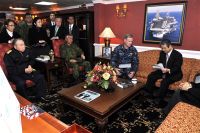WASHINGTON — As he prepares to turn over the reins of U.S. Pacific Fleet, Navy Adm. Patrick M. Walsh looks back with pride in his command’s adaptability in responding to last year’s earthquake and tsunami disaster in Japan.
Navy Adm. Cecil D. Haney, former deputy commander of U.S. Strategic Command, will take over as leader of the world’s largest fleet tomorrow. Walsh spoke about the challenges and opportunities facing America in the region during an interview earlier this week. Speaking from his headquarters at Pearl Harbor, Hawaii, the admiral talked about the U.S. military assistance effort, dubbed Operation Tomodachi, in response to the March disaster.
More than 15,400 people died in the tragedy. Coastal villages, towns and cities were almost obliterated by the earthquake and tsunami. American aid to the Japanese ultimately included 20 ships, including the aircraft carrier USS Ronald Reagan, almost 20,000 personnel, and huge amounts of supplies and heavy equipment.
Walsh was in Hawaii when the earthquake struck. He soon realized it was a catastrophic event for the Japanese, he said, and damage to the nuclear power plant at Fukushima made providing assistance that much tougher.
The U.S. military worked in support of the U.S. Agency for International Development. The experience, skills, education and training that military people possess was quite adaptable to the situation, he said.
“It was important that we had a force that was forward, that was ready, that was credible, and that has relationships that extend well beyond simple military-to-military ties,” Walsh said.
American service members had a long history of working with Japanese counterparts and understood the culture and sensitivities, the admiral noted. The “can-do” attitude of American commanders in the region helped tremendously, he added.
“You have the forward-deployed naval officers who aren’t waiting for orders to move ships, but are reacting and responding quickly,” the admiral said.
Walsh stressed the importance of building relationships with regional partners, and the longstanding relationship with the Japanese was crucial to this effort. “It’s important to say this was not a cold start for us,” he said. “We had personal contacts with our counterparts in the region long before the earthquake and tsunami.”
American officials knew who to call and what to say to their Japanese counterparts as soon as the extent of the disaster became known, Walsh said, and Pacific Fleet has the experience and contacts to do this in other parts of the region.
“The flexible and adaptive capabilities of the force and the experience base of the force would work in other situations,” Walsh said. “We would, of course, have to tailor our approach to the needs of other countries.”
Source:
U.S. Department of Defense
Office of the Assistant Secretary of Defense (Public Affairs)

 von
von 